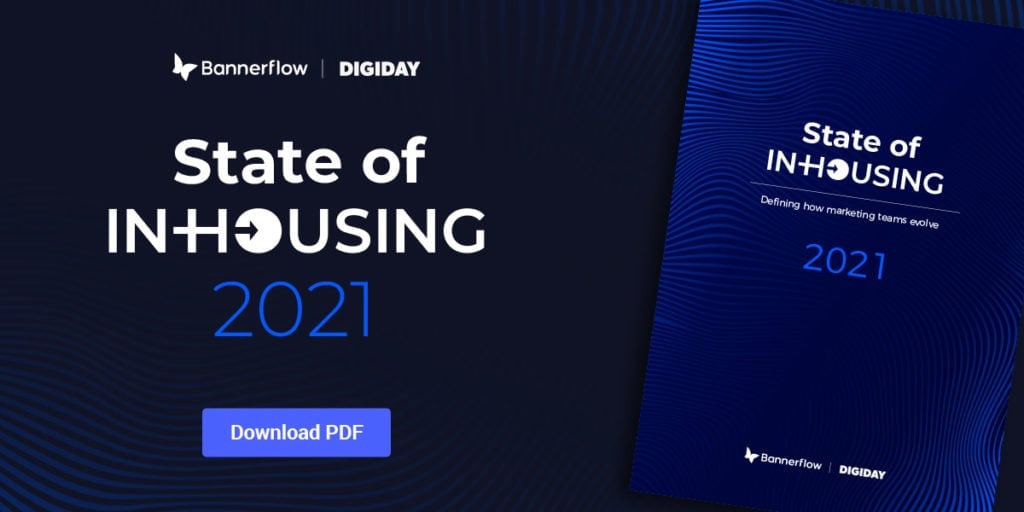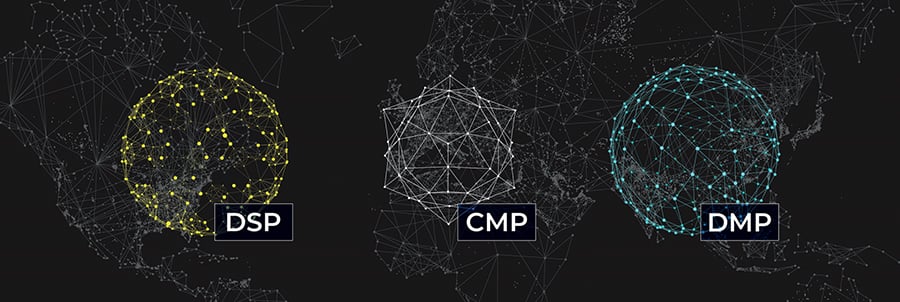It’s no secret that COVID-19 has accelerated the adoption of digital transformation technologies across many, if not all, industries. In fact, IoT Now suggests that the pandemic has fast forwarded this by 5.3 years in the last 12 months alone.
This can be hard to achieve in practice if you don’t have a strategy for digital transformation within a workable framework for your particular business.
What’s clear is that keeping your finger on the pulse of technology can heighten efficiencies and provide increased value for customers and consumers. In fact, 63 percent of the Bannerflow State of In-Housing 2021 brands said they experienced ROI uplift since in-housing.

However, attempting to implement these changes without a strategy in place first can be the difference between success and failure.
In this guide, we’ll discuss what a digital transformation strategy is, what a framework is and the different types of framework some consultants and experts have already created. We’ll also drill down into the importance of getting the correct strategy and structure to suit your organisation, plus the technology that’s available to harness your plans.
What will we be covering in this digital transformation strategy guide?
1. What is a digital transformation strategy?
- What’s the aim of a strategy?
- Think customer loyalty and new opportunities
- What does an effective digital transformation strategy look like?
- How can having a strategy for digital transformation help my business?
- How can in-housing and tech tools help?
2. What is a digital transformation framework?
- Framework examples
3. Digital transformation technologies
- Digital transformation tools
What is a digital transformation strategy?
Essentially, a digital transformation strategy is an action plan that sets out how a business can prosper in the digital world. Due to evolving consumer habits, the increased need for efficiency and more, businesses need to utilise technology to remain competitive in their sector. Everything is moving into the digital sphere. Therefore businesses need to keep pace with the swift uptake of technology around the world, in all aspects of life.
Different industries will have differing opinions on what a digital transformation strategy is and means for them. Across the board, though – a strategy for digital transformation requires the tech to transform an organisation into something that’s both more valuable for a consumer and more structured for everyone.
However, a strategy also requires the people within a business to be on board with these transformations, using the technology available to them and working on innovative future plans.
What’s the aim of a strategy?
The aim of a strategy should be to intentionally move an entire business, from the bottom up, across to a fresh, exciting setting within the digital landscape. Indeed, it should explain why a change is needed – and sum up the situation as it stands as well as the end goal.
For example, Microsoft took five years to go through the digital transformation process because they could explain why a change was required. Previously the market leaders, they noticed their stock prices dipping and rival companies increasing their dominance.
An article in Forbes shows some of the value of their digital transformation. Before embarking on the journey in 2014, revenue was $93.5 billion – five years later it was $122 billion.
Think customer loyalty and new opportunities
Dealing in basic tech is no longer enough to attract customers and maintain loyalty, consumers expect more and you have to deliver that in order to impress and compete. Your business needs to personalise, evolve with predictive analytics, be innovative and harness data to your advantage. Your strategy should outline how you can let go from current processes to create space within job functions for this new way of working.
Furthermore, a strategy can also deal with how you’re going to become innovative with the technologies you employ to create fresh opportunities not previously sought. So, how will you manage this and which roles will be responsible for this progress?
What does an effective digital transformation strategy look like?
As we’ve touched upon, the components that make up a successful strategy will look different from organisation to organisation. However, there’s thought to be three essential elements to any strategic plan.
Professor of strategy at UCLA’s Anderson School of Management, Richard Rumelt, published a book in 2011 called Good Strategy/Bad Strategy. Within this body of work, Rumelt names his ‘Kernels of Good Strategy’.
These three elements, or kernels, are:
- A diagnosis – this should explain, or even define, the nature of the challenge ahead.
- A guiding policy – this should address how to deal with the challenge.
- Coherent actions – these actions should be created to carry out the guiding policy.
Parsons Corporation CEO Chuck Harrington hit the nail on the head with his review of Rumelt’s work when he said:
“Richard Rumelt reinforces that a strategy is not a goal or objectives. It is the battle plan for action that is designed upon a unique set of attributes or conditions (kernels) that sets an organisation apart from its competitors (leverages) and results in exceptional and sustainable profits.”
How can having a strategy for digital transformation help my business?
Quite simply, having a strategy for your digital transformation efforts can help your business to make these changes efficiently, save on costs and deliver increased value to your customers. This can only be achieved by having buy-in from across the organisation – something that’s essential for a successful transformation.
Why is that? Well, a strategy ensures that every aspect of your business is accounted for and aligned with your digital evolution. Without it, you’ll have people within your organisation completely at a loss for how they’re supposed to be contributing to the changes.
A clear plan helps give knowledge to employees – through this they become empowered to action the changes required from their role and department. Get them onside with a compelling vision.
This is important to note – without a plan of attack for your digital transformation efforts, nothing productive will happen and a lot of money and time will have gone to waste. If a strategy and guidance is lacking, people will default to what they know, stick to old, outdated processes and practices. In this instance, tech you’ve invested in will be a wasted resource.
How can in-housing and tech tools help?
Bringing everything in-house can ensure a transformation is efficient and cost-effective. This can be key to convincing everyone within an organisation that this is the direction to take. Our 2021 in-housing report showed that 32 percent of respondents have increased their in-house teams by three to five people. This puts the power back into the hands of individuals working within a business. When marketing efforts are outsourced, processes can be slowed down and be far less efficient.
Employing the use of powerful technologies and tools can be extremely helpful with this. Of those surveyed as part of our in-house marketing report in 2021, 58 percent are using data more than ever before. An impressive 55 percent say creativity has increased, while 54 percent also say they’re seeing greater collaboration.
Having the right skills at your disposal within your own organisation in combination with the appropriate tech can improve your time-to-market substantially. It also brings the ability to be agile and grow exponentially.
Take a read through some of our interviews with Bannerflow’s in-house clients to get a better idea of how this could work for you:
- Telia’s Digital Transformation: Innovation In Telecom Marketing
- In-house Marketing At Klarna: Interview With Elin Svahn
- Dynamic In-house Display Advertising With Kindred Group
- How Meliá Hotels International Produces DCO Advertising In-house
- In-house Display Advertising And DCO With Casumo
What is a digital transformation framework?

A digital transformation framework is essentially a blueprint for your company to work from and adhere to before embarking on a journey of transformation. This is the formal plan for how and when an organisation will modify and enhance its processes in the digital space.
With the framework in place and in motion, a business can take charge of its transformation strategy, implement and monitor their technologies rather than being reactive. Holistic changes such as transforming your business processes require a framework. With this, no stone is unturned and each department is assisted through the changes.
Working from an effective strategy framework for your industry and company also ensures there’s buy-in from across the business. This way, each job role can be guided through the transitional period.
Framework examples
There are a number of different digital transformation framework examples to follow. Plus, several opinions and theories as to what these should look like.
This is largely down to a simple fact – digital transformation is an overarching term and it’s not specific for any one sector. Therefore, what works for your industry won’t necessarily work for another.
By understanding what’s included in different frameworks, digital transformation strategists and consultants can choose relevant elements. This creates something bespoke that’s robust, workable and comprehensive for an organisation.
A number of digital transformation experts, consultants and businesses have created strategy frameworks which they believe to be the benchmark for a successful transition.
Additionally, it’s worth getting a better idea of the elements you’ll need to consider. Below are some examples of digital transformation frameworks created by strategic experts. Use these as inspiration to find your own path to an effective framework.
McKinsey & Company
The management consultancy firm, McKinsey & Company has identified a 10-step plan for digital transformation success. As detailed by Consultancy.uk, McKinsey’s framework is as follows:
- Buy-in from senior management
- Setting clear targets
- Invest
- Target short-term, measurable projects
- Identify a premium launch team
- Encourage agile ways of working
- Work on digital culture
- Sequence initiatives
- Develop workforce capabilities
- Outline a new operational model
Medium
A 2020 article written on the Medium.com platform highlights the digital transformation undertaken by The New York Times and offers a four-step framework for success. These for components are:
- Creating an integrated business strategy driven by digital
- The act of digitising the core business operating model
- Discovering fresh opportunities for growth digitally
- Advancing and bringing digital transformation enabler in alignment (people, organisation, data and analytics, ecosystems and tech)
Deloitte
The professional services network, Deloitte calls its framework a ‘high-level roadmap for digital transformation based on the business architecture concept’. Within four pillars, there are further steps for businesses to apply within their structures. The four steps for this roadmap are:
- Make an assessment of both the external and internal situation
- Create a strategy and evaluate business impacts
- Design and develop a business architecture solution
- Organise initiatives and establish solutions
Gartner
This research and advisory organisation has devised six key steps towards building a successful digital business. Gartner’s six-step framework includes:
- Build a shared understanding with the right mindset
- Ensure the correct leaders are in situ
- Create a centre of excellence for your digital business
- Produce a digital strategy
- Discover and develop roles with digital business skills
- Generate fresh capabilities
Digital transformation technologies
From cloud computing, to artificial intelligence (AI), being able to harness the power of digital transformation relies on the technologies available to do so. By embracing exciting technologies such as augmented reality, the transformation of processes into the digital landscape can create unrivalled efficiencies.
Game-changing digital transformation technologies:
- Cloud computing
- Artificial intelligence (AI)
- Augmented reality (AR)
- Internet of Things (IoT)
- Mobile
This kind of tech in combination with big data, analytics and a cultural change in a business from the bottom up can produce amazing evolution with a strategy. Research these thoroughly and ask yourself ‘how can we use this to make our business better?’.
Digital transformation tools
Having the right tools at your fingertips is key to any successful framework and strategy for an organisation’s digital transformation.
For instance, is your business hoping to transform its capabilities in the digital advertising sphere? Cloud-based software such as Bannerflow’s creative management platform (CMP) could be invaluable.
With its robust cloud-based platform, and smart production AI the digital advertising output of any business can be transformed. Bannerflow empowers brands to devise and manage their digital advertising from a single solution.
This, in essence, is a digital transformation in itself! Due to the fact it’s a process that would previously have included the input of external agencies, plus several people and numerous tools. With a CMP, this process can be brought in-house and completely streamlined through utilising knowledgeable team members and powerful tech.
Not only can this create unrivalled efficiencies, but it can also perform at scale – a powerful combination. This platform can perform for a business across multiple languages and channels and in several markets at once, on mass and in real-time.
An organisation’s creative departments can have complete command over the output of the brand – design, scheduling, publishing and real-time optimisation – from this one solution.
No matter which industry you operate in, harnessing the capabilities of this kind of tech within your digital transformation framework can set you apart from the competition.
Conclusion
The importance of having a digital transformation strategy and embracing the correct technologies and framework for your business cannot be underestimated.
The key to success is not focusing on any one aspect in particular and instead taking a holistic approach. Invest in cultural change and the open communications that come with that, promote collaboration and get buy in for the tech but don’t solely focus on it.
This kind of comprehensive approach to transforming your business model can certainly create a recipe for success – especially with the right people guiding the process.
Lastly, if this guide has ignited your interest in making changes to your digital marketing and advertising efforts and you want to give a CMP a try, we can help. Apply for a demo with Bannerflow and experience the CMP process for yourself and gain an understanding of how this can work for your brand.
Allow us to offer a helping hand to empower your in-house creatives with creating personalised and memorable digital advertising campaigns with our premium platform.






